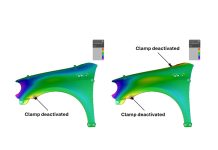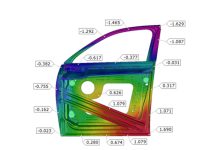Estimating stamping piece costs is a challenge for nearly everybody in the sheet metal value stream. To bring sheet metal product to market, you rely on numerous cost estimates to prove that the product is worthwhile, win new projects, select suppliers, and ultimately assure your operation’s profitability.

Cost estimating need not seem “mystical”
Industry has sought various solutions to improve the cost estimation accuracy; however, disparity in methodology, inputs, time requirements, and the results leaves significant doubts. The challenge in addressing such costing disparity lies in the availability of information about the product, planned tooling process, and required production resources.
Historical analyses
One common approach for initial cost estimates is to reference historical costs taken from individual experience, spreadsheets, databases, or ERP records. Such methods seem to be reasonable cost estimation tools; they often show what we truly spend, and provide useful “hindsight.”

When quoting , can we assume historical ratios of expenses hold true? Is it likely that some costs are not scalable?
Many historical analyses are “top-down” attempts to correlate an overall cost of previous projects with the requirements of different categories of expenses, like engineering, materials, build/tryout costs or tooling costs, part material costs, production line costs, and shipping costs. If guidelines for recognizing part classifications like size, complexity, or application are used, one can reason that future parts with similar classifications might follow similar patterns for overall cost and the cost per category of required expenses.
The use of historical methods has risks. Assuming that similar parts will follow the same ratios for percent engineering, materials, and build costs is potentially disastrous and could lead to significantly under-predicting required tooling resources for the die. One cannot assume that every similar part classification follows consistent ratio of expense for tooling, scrap and offal costs, production line costs, and shipping. Some stamping processes will require more die material or purchased components than others, which a top-down method cannot predict. Part features can drive production processes that use more sheet metal than others.
Other issues with historical methods:
- Does data include consequences of accidental overruns and waste?
- Does it allow for good/bad luck?
- Does the data reflect price or costs?
- Does data include unprofitable work?
Length of line rules with preliminary process sketches
To improve upon historical analyses, it is common to use preliminary process plans and measurements of product features to tabulate potential costs. This enables the estimator to recognize that each part that they quote is unique. Similar class parts are no longer grouped into an assumed cost range; instead, costs are estimated feature by feature.
There are many ways to perform these analyses –in-house spreadsheet solutions, downloadable templates, commercial ERP plug-ins– but they all share the following concepts:
- Predicted tool size, number of operations multiplied by die set cost factor
- Count the holes, group by size, multiply by cost factor per hole
- Measure flanges, multiply by cost per unit length, tabulate each flange in the part
- Measure the trimming and blanking lines, multiply by cost per unit length

Length of line methods applies cost factors per unit size of key features and allows user to tabulate costs
Measurements can be taken using a proposed process, which the estimator can make by hand or create using CAD or graphics programs. The estimator then measures and counts the features and visualizes the number of operations for the approximated pitch and width.
- Does the blank recognize any need for addenda or progressive carriers?
- Did the user multiply by the correct length?
- Did the operator enter one too many zeros in the length of line?
- Are the cost factors based on reliable data?
- Is the process sketch realistic for the number or type of operations?
- Are cost factors insensitive to differences in press lines?
Discretizing the costs of the specific features increases the precision of the cost estimation. However, when searching for the origins of the cost per unit length/size of features, one finds that most have arrived at the cost-per-feature by reverse-engineering historical data, which is flawed (as mentioned earlier). The estimate represents the appearance of objective data, but is based on risky assumptions.
3-Dimensional Strip and Die Layout with Bill of Materials
Another trend in tool cost estimation and quoting is the use of progressive 3-D strip layout and power-copy-generated 3-D tool solids and proposed bill of materials. This type of bottom-up costing will very likely capture the cost of the required materials and components accurately, assuming the 3-D design from quoting is the same as it? is manufactured. However, this practice introduces “work-at-risk”: hours, if not days, of engineering effort to quote on a job that likely has a low percent chance of winning. Many progressive stampers demand 3-D strip drawings with quotes, but could we ask the level of detail for large transfer tools? Probably not. This leads to disparity in costing methods for those who use both types of tools.
One thing to rule them all
It is clear that each method’s applicability is limited by the amount of information available during the cost estimation. If no process can be aligned with the product geometry, then only historical analysis can be applied. Once a process proposal is described, estimates can be developed using length-of-line methodologies. By the time a full 3-D layout is created, it may be too late to be a viable estimate.
Our solution for planning and bidding is a software solution that enables the user to arrive at cost estimates with similar effort as in any historical analysis. Users can define the process loosely, using automated process proposals to estimate resource requirements, or take the time to capture the specifics of the decisions required for the specific part. This method is just as fast as guessing, but far more reliable and can be improved upon when and if you have the time. Using a process description associated with real 3-D part data, our solution develops a bottom-up resource-based price estimate that can’t be improved upon until the full die design is complete. Of course, once a 3-D model is completed, it is not really estimating anymore.














[…] look back at historical expense proportions and assign those proportions to future parts. Such “top down” approaches can rarely discretize the bottom line in such a way that comparison to actual costs is […]
Nice explanation, Thanks! In this mode, the intention is to assign actual units (hours) and costs to resources, then calculate units and costs to completion, and possibly conduct an Earned Value analysis. In this situation, it is important to ensure that the minimum number of resources are assigned to activities, and preferably only one resource assigned to each activity. The process of updating a schedule in Sydney becomes extremely difficult and time consuming when a schedule has many resources per activity. The scheduler is then under threat of becoming a timekeeper and may lose sight of other important functions, such as calculating the forecast to complete and the project finish date. Primavera P6 tool is really usefull to manage this process